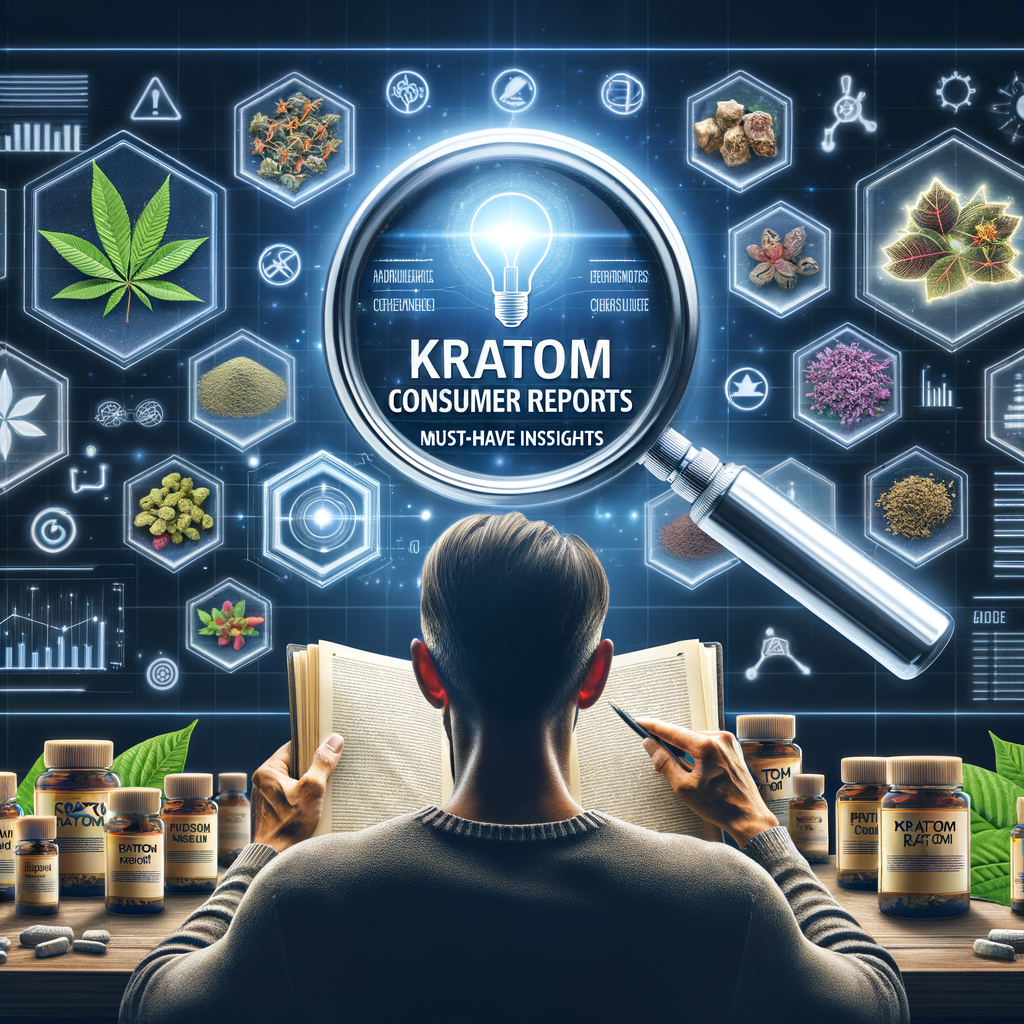
Kratom Consumer Reports: Must-Have Insights for Smart Choices
- Understanding Kratom: An Overview
- Health Benefits of Kratom
- Pain Relief
- Mood Enhancement and Anxiety Relief
- The Risks of Kratom
- Side Effects to Consider
- Legal and Regulatory Concerns
- Choosing the Right Kratom Product
- Factors to Consider
- Sourcing High-Quality Kratom
- Dosage Guidelines for Kratom
- Starting Slow
- Finding Your Perfect Dose
- Combining Kratom with Other Substances
- Stacking Approaches
- Avoiding Dangerous Combinations
- Community and Support
- Engaging in Discussions
- Seeking Professional Guidance
- Final Thoughts
- Frequently Asked Questions
- 1. Is kratom safe to use?
- 2. What is the legal status of kratom?
- 3. Can kratom interact with medications?
- 4. How does kratom affect mood?
- 5. What is the best kratom strain for beginners?
- 6. How should I store kratom?
- 7. Can I combine kratom with other supplements?
- 8. How long do the effects of kratom last?
- 9. Can I become addicted to kratom?
- 10. Where can I find reliable kratom vendors?
- References
Understanding Kratom: An Overview

Kratom, scientifically known as Mitragyna speciosa, has gained immense popularity in the wellness community. Derived from the leaves of a tropical tree native to Southeast Asia, kratom offers a variety of effects. People use it for pain relief, mood enhancement, and energy boosts. However, as with any substance, understanding its benefits and risks is crucial for making informed decisions.
Kratom contains alkaloids that interact with opioid receptors in the brain. This interaction produces effects that range from stimulation at lower doses to sedation at higher doses. While some users praise its potential, others caution about its legal status and health impacts. Understanding these complexities helps consumers navigate their choices wisely.
Kratom is available in several forms, including powders, capsules, and teas. Each form varies in potency, dosage, and onset time. This diversity ensures that there is a product to suit various preferences. However, the varying quality and purity of kratom products also pose challenges. With so many options, how do you choose the right one?
Health Benefits of Kratom
Pain Relief
Many kratom users report significant relief from chronic pain. The alkaloids present in kratom, especially mitragynine and 7-hydroxymitragynine, are responsible for this effect. These compounds help reduce pain signals in the brain, similar to how traditional pain relievers work. However, kratom functions in a more nuanced way, offering a tailored experience depending on the dosage.
For individuals suffering from conditions such as arthritis or fibromyalgia, kratom can be a game-changer. Users often choose kratom over pharmaceuticals to avoid the side effects associated with stronger medications. Furthermore, customers frequently report that kratom helps reduce dependence on other painkillers.
Mood Enhancement and Anxiety Relief
Kratom is not just about physical benefits; many users experience enhanced mood and reduced anxiety. This effect largely stems from the stimulation of serotonin and dopamine levels in the brain. Users feel happier and more focused after consuming kratom, making it a popular choice among those dealing with depression and anxiety.
Research indicates that kratom may help improve emotional well-being. However, the experiences vary from person to person. Some may feel energized and ready to take on the day, while others find a tranquil calm enveloping them. This dichotomy highlights why understanding your own body is crucial when exploring kratom.
The Risks of Kratom
Side Effects to Consider
Despite the benefits, kratom does have its fair share of side effects. Common issues include nausea, constipation, and dizziness. While many users tolerate kratom well, some experience unpleasant reactions, especially at higher doses. As with any substance, listening to your body is essential.
Long-term use poses additional risks. Dependence can develop, leading to withdrawal symptoms akin to those experienced with opioids. Users may find it challenging to cease use if they maintain high dosages over extended periods. The potential for addiction makes it vital to approach kratom with caution.
Legal and Regulatory Concerns
Kratom’s legal status varies worldwide. In some countries, it remains legal and widely accepted. In others, bans or restrictions exist due to safety concerns and potential for misuse. Before purchasing kratom, understand the laws in your area. Always source it from reputable suppliers, as quality can vary greatly.
The U.S. has seen ongoing debates about kratom’s regulatory status. The Food and Drug Administration (FDA) has expressed concerns about its safety and efficacy, labeling it as a supplement not approved for use. This lack of regulation means consumers need to be even more vigilant about the quality and purity of products.
Choosing the Right Kratom Product
Factors to Consider
When selecting kratom, several factors come into play. First, consider the strain. Kratom is available in different strains, each offering unique benefits:
– Red Strain: Known for its calming and sedative effects, ideal for evening use.
– Green Strain: Offers balanced properties for both energy and relaxation, versatile for any time of day.
– White Strain: Provides stimulating effects, perfect for boosting focus and energy when needed.
Next, pay attention to the product form. Powders offer flexibility in dosing, while capsules provide convenience. Teas can also be a soothing way to digest kratom. Ultimately, your lifestyle and preferences guide your choice.
Sourcing High-Quality Kratom
Not all kratom is created equal. When choosing a product, always seek reputable vendors. Look for companies that provide third-party lab testing. This testing ensures the product is free from contaminants and accurately labeled by potency.
Check for transparent sourcing practices and customer reviews. A trustworthy vendor will share information about where their kratom is sourced. Reading testimonials from fellow consumers can give you insight into product quality and effectiveness.
Dosage Guidelines for Kratom
Starting Slow
Starting with a low dose is essential, especially if you are new to kratom. Many suggest beginning with around 2-3 grams. Gradually increase your dose based on your experience, comfort level, and desired effects. Always wait multiple hours between doses to assess how your body reacts.
Finding Your Perfect Dose
After your initial experience, you may want to adjust your dosage. For mild effects, 2-4 grams may suffice. However, for stronger effects, some users report benefiting from doses up to 6-8 grams. Remember, everyone’s body chemistry is different, so what works for one person may not suit another.
Keeping a log can help track your experiences with different doses and strains. Documenting how you feel after each dose will lead to smarter choices in the long run.
Combining Kratom with Other Substances
Stacking Approaches
Some users choose to combine kratom with other substances to enhance the effects. This practice, known as “stacking,” can be risky. Combining kratom with other stimulants, such as caffeine, may amplify anxiety and result in adverse reactions. Always approach stacking cautiously.
If you decide to combine substances, research potential interactions thoroughly. Many combinations can lead to unpredictable outcomes. Staying informed about the effects and risks associated with each substance is crucial for safety.
Avoiding Dangerous Combinations
Certain combinations should be avoided entirely. Mixing kratom with alcohol or certain medications can lead to dangerously heightened side effects. Always consult a healthcare professional before mixing kratom with prescription drugs, especially narcotics or benzodiazepines.
Assess your individual risks based on your health background and any medications you take. Protecting your well-being should always come first.
Community and Support
Engaging in Discussions
Joining kratom communities can help enhance your understanding and experience. Online forums, social media groups, and local meet-ups offer valuable insights. Engaging with others allows you to share stories, challenges, and tips for smart kratom usage.
Many users report finding support and encouragement from these communities. They play a vital role in helping newcomers feel welcome and informed. The collective wisdom shared can guide smarter, safer choices.
Seeking Professional Guidance
While community support is invaluable, professional guidance remains essential. If you’re considering kratom for specific health reasons, consult your doctor or a healthcare provider. They can offer tailored advice and ensure you choose the safest options.
Healthcare professionals can help monitor effects and interactions with existing medications. This cooperation fosters a more holistic approach to health and wellness.
Final Thoughts
Navigating the world of kratom can be overwhelming. With its complexity in effects, risks, and products, educated decisions are vital. Understanding the benefits and drawbacks allows you to choose wisely and embrace the potential kratom offers responsibly.
As with any substance, moderation is key, and seeking information is crucial. Kratom may offer unique benefits, but your well-being should always come first. Stay informed, trust your instincts, and connect with others in the community. These steps pave the way for a balanced, informed kratom experience.
Frequently Asked Questions
1. Is kratom safe to use?
While many users report positive effects, kratom can have side effects and potential for addiction. Always start with low doses and consult healthcare professionals.
2. What is the legal status of kratom?
Kratom’s legality varies by country and state. It’s essential to check local regulations before purchasing or using kratom.
3. Can kratom interact with medications?
Yes, kratom can interact with various medications. Consult a healthcare provider to discuss any potential interactions.
4. How does kratom affect mood?
Kratom can enhance mood and reduce anxiety for many users. It increases serotonin and dopamine levels, though individual experiences may vary.
5. What is the best kratom strain for beginners?
Most beginners start with a green strain, as it offers balanced effects that cater to energy and relaxation.
6. How should I store kratom?
Store kratom in a cool, dark place in an airtight container. This helps maintain potency and freshness.
7. Can I combine kratom with other supplements?
While some users combine substances, this can lead to risks. Always research potential interactions thoroughly.
8. How long do the effects of kratom last?
Effects typically last 2-6 hours, depending on dosage and individual metabolism.
9. Can I become addicted to kratom?
There is potential for dependence with heavy and prolonged use. Moderation and awareness are crucial.
10. Where can I find reliable kratom vendors?
Seek vendors that offer third-party lab testing, customer testimonials, and transparent sourcing practices for quality assurance.
References
– Kratom: A Comprehensive Guide
– Kratom – Uses, Risks, and Effectiveness
– FDA on Kratom
– Consumer Reports on Herbal Supplements

